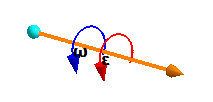Inertia Loads
An inertia load is a body load uniformly distributed over the volumes of the parts in an assembly.
Translational Inertia Loads
Common values for gravity at sea level are 9.81 m/s^2 or 386.09 in/s^2.
Rotational Inertia Loads

Inertia Relief
Inertia relief is applied to a structure in order to simulate deformations and stresses in cases where the structure is unconstrained so it can move as a rigid body, and an active load is suddenly applied to the structure, so the structure starts moving with translational and rotational accelerations.
Typical applications of inertial relief are an airplane in flight or a satellite in space.
The solution to the problem of analysis of unconstrained structures is based on d'Alembert principal. The principal states that the structure will be in static equilibrium if the active loads are complimented by fictitious inertia loads evaluated through the structure accelerations. Therefore, in inertia relief analysis, fictitious inertia forces are calculated and distributed over the volume of the structure in such a way that they are in exact balance with the user applied forces.
In SimSolid, when analyzing the inertial relief, there is no need to apply additional constraints which would eliminate rigid body motions of the structure. The user simply specifies the active loads and the rest is done automatically.